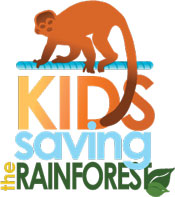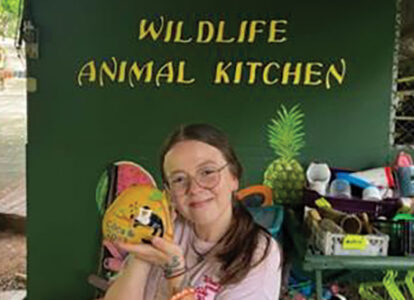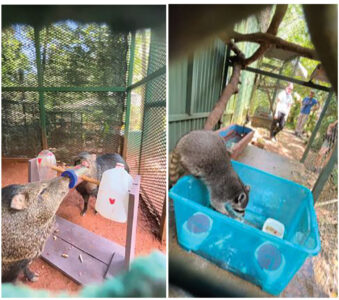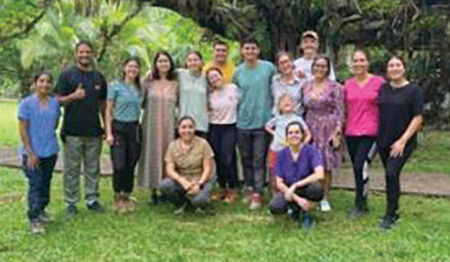A Month at KSTR
 Hi guys! My name is Coralie, but everybody calls me Coco, I am 20 years old, and I am from Montreal, in Canada. I am about to finish my last year of study to become a veterinary technician in Quebec and I volunteered as an intern at KSTR for a month in the sanctuary.
Hi guys! My name is Coralie, but everybody calls me Coco, I am 20 years old, and I am from Montreal, in Canada. I am about to finish my last year of study to become a veterinary technician in Quebec and I volunteered as an intern at KSTR for a month in the sanctuary.
 Going to Costa Rica was my first-time solo traveling. I didn’t know what to expect from this internship since I didn’t have much experience with wild animals such as the ones we have at Kids, but I was really excited to be able to work for a month with these species and learn about wildlife rehabilitation. Going from Montreal to Quepos was quite a long ride! I had to take two planes, then the bus to get to the volunteer center, where I would spend the next 4 weeks. As soon as I got there, I immediately felt amazed by the nature teeming with life: toucans flying over my head, mountains touching the sky, monkeys leaping from trees to trees… and what about the warm welcome I received upon my arrival! We were a few girls sleeping in the dormitory and each of them made sure that we were comfortable in what was going to be our home for the month. We got to know each other a little bit better over the next few days and I really enjoyed learning about everybody’s countries and experience at kids.
Going to Costa Rica was my first-time solo traveling. I didn’t know what to expect from this internship since I didn’t have much experience with wild animals such as the ones we have at Kids, but I was really excited to be able to work for a month with these species and learn about wildlife rehabilitation. Going from Montreal to Quepos was quite a long ride! I had to take two planes, then the bus to get to the volunteer center, where I would spend the next 4 weeks. As soon as I got there, I immediately felt amazed by the nature teeming with life: toucans flying over my head, mountains touching the sky, monkeys leaping from trees to trees… and what about the warm welcome I received upon my arrival! We were a few girls sleeping in the dormitory and each of them made sure that we were comfortable in what was going to be our home for the month. We got to know each other a little bit better over the next few days and I really enjoyed learning about everybody’s countries and experience at kids.
During my stay, I got to learn about Costa Rican fauna and I got to know all the permanent residents. While cooking delicious fruit and vegetable salads twice a day for them, I learned the particularities of the diets of each animal: the parrots would eat smaller pieces of fruits, the sloths and the kinkajous eat only in the afternoon, the peccaries needed corn in their meal and the monkeys would love to remove the fruits peel themselves. Even though most of the permanent residents of the sanctuary are kept in captivity only because they are too acclimatized to humans, some of them are there because they absolutely cannot be released for medical reasons. Thus, after breakfast, medication must be prepared for permanent residents who need it. For example, Fozzie, a 2-toed sloth, has a liver problem, so she must receive 3ml of her medicine once a day to help her function. Nina, a 33-year-old spider monkey, must receive a pill for her arthritis, so I had to make her banana and peanut butter sandwiches to hide the medication every day. We also had to make one (without medication!) for her monkey friend, Darwin, so he didn’t get jealous! It was fun to learn about each animal personality and watch them interact differently with every staff member and volunteer.
One of my favorite parts of my job was to make enrichments for the animals. Since captive environments can be less challenging and stimulating, it is important to offer them a living space that will provide them a good quality of life. Enrichment can be provided by improving the enclosures such as putting in new plants, ropes, or hideouts, by giving them toys or puzzles to make their brain work and do some exercise and it can be complemented by hiding pieces of food as a treat! I loved how they were excited when they saw me coming in the enclosure with something for them. It was crazy to see how they were fast to resolve the puzzles I would create for them!
 In the first picture, the peccaries were playing with a game I made. They had to spin the bottles with their snout to make the peanuts fall on the ground. On the second one, Zorro the raccoon was exploring in the sensory bin that I filled with pebbles, plastic containers, dead leaves, and water, looking for the tiny pieces of crab that I hid there. This was a good enrichment for him, because raccoons have lots of nerves going in their hands and they use them as a second set of eyes to look out for food in the wild.
In the first picture, the peccaries were playing with a game I made. They had to spin the bottles with their snout to make the peanuts fall on the ground. On the second one, Zorro the raccoon was exploring in the sensory bin that I filled with pebbles, plastic containers, dead leaves, and water, looking for the tiny pieces of crab that I hid there. This was a good enrichment for him, because raccoons have lots of nerves going in their hands and they use them as a second set of eyes to look out for food in the wild.
I I also loved participating in tourist visits by accompanying day volunteers in an enrichment making activity. I could therefore explain to them the importance of it and teach them various facts about the behavior of our residents. I really liked this contact with humans too because I wanted to share with them my passion about wildlife conservation and about my work at KSTR. Most people were very interested in participating, even if they had never heard of this kind of practice before. In addition, it allowed me to practice my English and my Spanish, since the tourists were mostly English or Spanish speaking and that I mostly speak French in Montreal!
During my stay at KSTR, every staff member and volunteer was so welcoming and so kind, and I could really feel like I was a part of the team since the beginning. It was a safe place to be myself and just enjoy the wonderful rainforest around me. Pura Vida is real!
 Now that I am back in Quebec, I feel so grateful for this experience. I have met amazing friends from all around the world, practiced two other languages, discovered the culture of another country, and worked with the most interesting animals.
Now that I am back in Quebec, I feel so grateful for this experience. I have met amazing friends from all around the world, practiced two other languages, discovered the culture of another country, and worked with the most interesting animals.
Volunteering at KSTR is a wonderful experience if you want to open your horizons and feel like you are contributing to the preservation of our beautiful planet. It made me grow as a person and I would love to come back again someday. Miss you KSTR!
